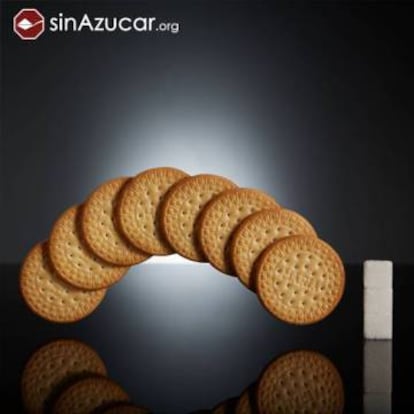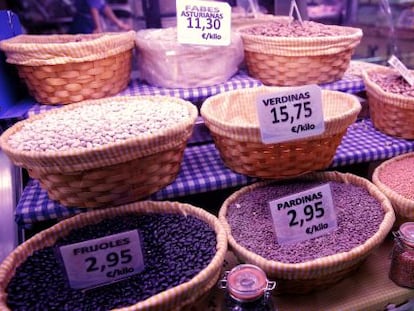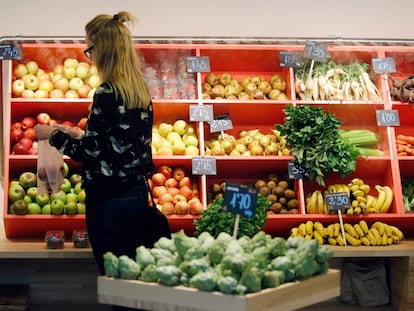Revealed: the hidden sugar in the food we eat everyday
Spanish initiative uses photography to show how major brands sweeten their products
A Danone 0% fruit yogurt contains four cubes of sugar; a 200ml carton of Spanish supermarket chain Mercadona’s tomato sauce, even more. A 50g helping of Kellogg’s cereals has four-and-a-half, while a Starbucks Mocca Blanco Venti with cream and chocolate syrup comes in at a whopping 20 cubes.

The World Health Organization (WHO) recommends consuming a quarter of the average amount of sugar that is consumed in Europe, which would take us down to 25g a day. But we are rarely aware of the amount of sugar we are putting into our bodies. Either we don’t read the labels, or we don’t understand them, despite the fact that sugar can be addictive and too much of it can lead to diabetes, obesity, dental problems and heart disease.
This general lack of awareness prompted Spanish photographer and healthy-eating advocate Antonio Rodríguez Estrada to set up SinAzúcar.org, an initiative that publishes photos of products along with their sugar content alongside them, measured in an easily understood unit: the cube.
“One of the reasons we have an obesity epidemic is the amount of processed food in our daily diet,” explains Rodríguez Estrada. “SinAzúcar.org is trying to make the hidden sugar in these processed foods visible in a simple and graphic way that can be easily shared on the social networks. It’s my grain of sand to help improve consumer habits.”
Although the US website Sugar Stacks or the Instagram account @dealerdesucre have been drawing attention to the problem for some time, Rodríguez Estrada’s initiative focuses on Spanish products while the glossiness of his photos deliberately imitates a promotional style. “The food industry seduces the consumer by dressing their products up in gloss,” says Rodríguez Estrada, who has just completed his studies in sports nutrition at the Spanish Institute of Health and Nutrition Sciences. “If we want to fight this kind of marketing, we have to use the same weapons they do and create attractive images that get the message across effectively.”
Rodríguez Estrada started by publishing photos of products loaded with sugar, such as fizzy drinks, but he soon switched to photos of products with surprising amounts of sugar, such as tomato sauce or baby food. In fact, he has decided to make a point of drawing attention to the sugar content in foods people believe are “safe,” due to the fact they are marketed as healthy, carry the 0% sign, or have been endorsed by medical corporations with questionable scruples.
To calculate the amount of sugar in each product, Rodríguez Estrada refers to the information on the label. When it comes to more generic foodstuffs such as sliced bread, cheesecake, chocolate donuts or sweets, he uses one brand as a reference. Each of his sugar cubes weighs 4g.
So now we have Rodríguez Estrada’s images to make us think twice about offering our children an energy drink, cookies or cereals; but why should we need someone like him to point it out? In short, how have we grown so ignorant of the amount of sugar in our food?
“One of the results of sugar abuse is that the sweetness threshold for our taste-buds rises,” says Rodríguez Estrada. “For food to taste good, we need more and more of it. If we get used to sugary yogurts, milkshakes and drinks at an early age, by the time we’re adults, a cup of coffee containing 20 cubes of sugar tastes delicious.”
SinAzúcar has been welcomed on social media sites by a number of dieticians and nutritionists, but Rodríguez Estrada hasn’t heard a word from the companies behind the products he has photographed. “None of them have contacted me so far,” he says, before adding wryly, “But every time I go to Starbucks I notice I get dirty looks...”
English version by Heather Galloway.
Edible products that simply aren’t “food”
While we could nitpick over the amount of sugar Antonio Rodríguez Estrada claims are in the products he has photographed, SinAzúcar.org is clearly a great way of exposing what certain sectors of the food industry are determined to hide from us. I am not exaggerating. In December 2012, four epidemiologists from London University informed us in the British Medical Journal that the food industry spent $1.4 million to stop the use of traffic-light style labeling on food. This labeling system is, in the opinion of many researchers, including myself (Public Health Nutr. 2014;17(6):1403-9), an effective way to improve public health precisely because it flags up certain nutrients which, if consumed in excess, are dangerous.
As far as sugar is concerned, there is solid proof that excessive consumption plays a role in chronic illness. One of the most recent guides published by the American Heart Association – Added Sugars and Cardiovascular Disease Risk in Children – points out: "there is strong evidence associating the consumption of added sugars with cardiovascular risk in children." (Circulation. 2016 Aug 22. pii: CIR.0000000000000439. [Epub ahead of print]). If we don't want our children to have a shorter lives than their parents, which now looks likely (JAMA. 2016;315(21):2269-70), it's time to recognize that there are foodstuffs that should not be considered "food."
Julio Basulto is a dietician and nutritionist and author of Se Me Hace Bola and Mamá Come Sano.
According to the experts…
Two years ago, a report was published concluding that a visual strategy, like Rodríguez Estrada's, was needed to tackle the current obesity epidemic. According to Juan Revenga, dietician and nutritionist and frequent contributor to El Comidista, "various European public health services have decided to take this route to try to combat the excessive consumption of sugar in society today.
“For example, Public Health England has released videos of typical breakfast cereals with the corresponding number of sugar cubes as part of their Change4Life program.”
Revenga believes that any initiative of this nature is welcome, and the more of them, the better. “We need to highlight the almost 60kg of added sugar that each Spaniard consumes every year.
Meanwhile, dietician and nutritionist Laura Saavedra also believes Rodríguez Estrada’s initiative is useful, since a picture is worth a thousand words, as the saying goes. “It makes the added sugar in different products visible at a glance,” she says. She does, however, suggest that Rodríguez Estrada enlist the help of professional nutritionists to work out the amount of sugar in each product. “This would help him to avoid making mistakes, as happened with the yogurt Actimel: besides the added sugar, he also counted the sugar naturally present in the lactose.”
“Projects such as SinAzúcar.org help health professionals fight diseases such as diabetes and obesity through prevention by educating the public about nutrition,” she adds. “And for those who still think sugar is necessary for the brain, the current director of the World Food Organization Dr Margaret Chan said some years ago that sugar is a zero when it comes to nutrition.”
Tu suscripción se está usando en otro dispositivo
¿Quieres añadir otro usuario a tu suscripción?
Si continúas leyendo en este dispositivo, no se podrá leer en el otro.
FlechaTu suscripción se está usando en otro dispositivo y solo puedes acceder a EL PAÍS desde un dispositivo a la vez.
Si quieres compartir tu cuenta, cambia tu suscripción a la modalidad Premium, así podrás añadir otro usuario. Cada uno accederá con su propia cuenta de email, lo que os permitirá personalizar vuestra experiencia en EL PAÍS.
¿Tienes una suscripción de empresa? Accede aquí para contratar más cuentas.
En el caso de no saber quién está usando tu cuenta, te recomendamos cambiar tu contraseña aquí.
Si decides continuar compartiendo tu cuenta, este mensaje se mostrará en tu dispositivo y en el de la otra persona que está usando tu cuenta de forma indefinida, afectando a tu experiencia de lectura. Puedes consultar aquí los términos y condiciones de la suscripción digital.
More information
Últimas noticias
The complicated life of Francesca Albanese: A rising figure in Italy but barred from every bank by Trump’s sanctions
How Japan is trying to avert ‘digital defeat’
Half of Scotland is in the hands of 420 property owners
From digital curfews to blocking apps: How technology experts protect their children online
Most viewed
- Why we lost the habit of sleeping in two segments and how that changed our sense of time
- Trump’s obsession with putting his name on everything is unprecedented in the United States
- Charles Dubouloz, mountaineering star, retires at 36 with a farewell tour inspired by Walter Bonatti
- The Florida Keys tourist paradise is besieged by immigration agents: ‘We’ve never seen anything like this’
- Living in a motorhome due to soaring housing prices in Madrid: ‘I got used to it quickly, but I don’t idealize it’












































